Nearing the end of their 4th year after seed-planting in this fully rodent and deer protected garden edge, these torreyas appear to be happy living in southwestern Ohio.
The learning here is not only that southwestern Ohio is already a fine climate for Florida torreya.
The learning is also that protecting against seed predation by rodents and early browsing by deer and rodents is vital for maximizing good results.
The PHOTO BELOW was taken by BOB MILLER August 2020. He lives in a rural section of Loveland, Ohio (northeast of Cincinnatti). This is the garden of his neighbor, who volunteered to shallow-plant 29 seeds in November 2015, just a few weeks after the seeds were harvested. Access the photo-rich multi-year webpage of Torreya in Loveland in Ohio.
It is a good thing that Bob initiated this planting off his own property, because almost all of the many seeds he planted directly into his forest were either predated by rodents or browsed down to nothing after germination (deer are abundant on his property).
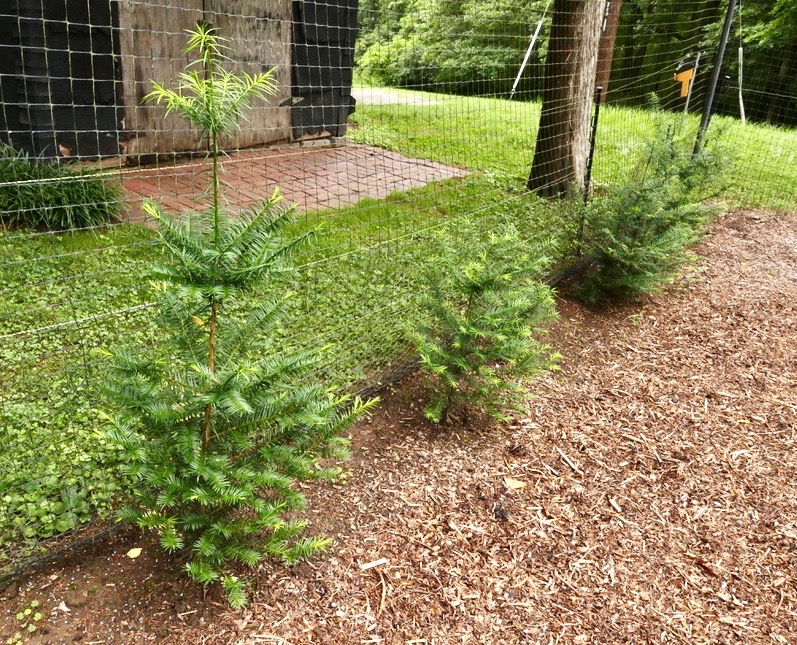
|
|
LESSON: The only reliable way to assess latitudinal and microsite suitability for Florida Torreya in assisted migration experiments requires:
(1) Harvest seeds properly and get them into soil in ground or pots as quickly as possible (and without letting them dry out after husk removal).
(2) Fully protect against all herbivores until the torreys are tall and shrubby enough to regrow after occasional browsings.
(3) Document and report results.
|
• August 2020: Evidence that Torreya is less susceptible to deer browse than Taxus (yew)
Richard Lawson of Dawes Arboretum (central Ohio) responded to an email report from Connie Barlow with a piece of relatively good news, given that site experiences of Torreya Guardians with their own young seedlings ranges from intensely destructive deer browsing to no browsing at all. In the latter instances, it is usually confirmed that deer are rarely seen in that locale. But at least it now seems that Torreya is not as attractive to deer as yew is:
RICHARD LARSON: "Connie - Thanks for the update including the surprising reproductivity of the species in northern Ohio [the Torreya grove planted by Fred Bess near Cleveland]. At The Dawes Arboretum we are encouraged by the performance of Torreya taxifolia, although our plants are not yet reproductive. I would now expect that our plants will achieve maturity and cone production. It appears also that the species is quite resistant to deer browse, and we are not obligated to fence them as with the closely related Taxus sp."
August 25 addendum by Richard Larson: "I expected deer to browse them [the torreya seedlings] and we do fence young plants in every case even though when they mature, they are resistant or rarely immune. But a recent planting has not been fenced for 2 years now and so far, no deer browse has been observed. That is only one example of course and hardly translates into declaring them as resistant as Asimina, Buxus, Berberis, Spiraea, Cryptomeria or Cephalotaxus, but it seems promising."
• July 2020: Torreya seeds too big for Gopher Tortoises to swallow (and disperse by defecation) — but a giant AFRICAN SPURRED TORTOISE was successful.
In 2015, Jason Richardson, PhD Student, Department of Integrative Biology, University of South Florida, wrote to Torreya Guardian Lee Barnes to access seeds for a REPTILIAN SEED DISPERSAL: Feb 3, 2015, Jason Richardson wrote to Lee Barnes:
"... I would like a pack of seeds. I assume Connie or Jack had me added to this list. If you are unfamiliar, I am a PhD student at the University of South Florida. For my dissertation, I am examining the effects gopher tortoises have on plant community composition, and also how they affect germination of seeds in their diet. I am particularly interested in how they may enhance germination of rare and endangered plant seeds, and if they may be used in conservation efforts for such plants, and thus I emailed the Torreya Guardians about obtaining seeds." February 9: "I will be quantitatively testing germination rate and percentage as well as qualitatively examining the seed coat structure via electron microscopy. These two methods will be done both for ingested and non ingested seeds. I had not considered the stratification effects, could I get a pack of 20 of both stratified and non? More is always better for statistical analyses, but I think this will be a good start to see where it leads."
Note by Connie: Lee sent Jason seeds fr the 2014 harvest, but they were already cleaned of the fleshy covering that would be what tortoises are interested in. JACK SENT 2015 SEEDS with green flesh.
2020 REPORT OF RESULTS by Jason Richardson via July 21 email to Connie Barlow:
July 21, 2020, Jason Richardson wrote to Connie Barlow: "Seeds were unable to be consumed by gopher tortoises (too large). Any possible chelonian seed disperser is probably extinct. Seeds were fed to a sulcata tortoise at Zoo Tampa. Some were crushed but we did manage to collect a good number of them passed seemingly intact. I unfortunately had no germination success for these seeds, nor for the unpassed seeds. I have since graduated and am no longer working in science. If you are interested I can give you some other researchers who may be interested in trying to replicate or further this work."
Supplemental information by Connie Barlow: (1) Because Torreya seeds usually require 2 winters of cold stratification before germinating, it is possible that less time and/or insufficient cold were available for study prior to the need to publish results. (2) Richardson's PhD thesis can be found in full here; torreya seed experiments are not mentioned in it, however, "Seeds from the two fleshy-fruited species, O. humifosa and P. angustifolia, germinated in significantly greater proportions and faster after gut passage than seeds that did not pass through the gut." (3) Wikipedia entry on Sulcata Tortoise: "The African spurred tortoise (Centrochelys sulcata), also called the sulcata tortoise, is a species of tortoise, which inhabits the southern edge of the Sahara desert, in Africa. It is the third-largest species of tortoise in the world, the largest species of mainland tortoise, and the only extant species in the genus Centrochelys."
2019 Learnings
• December 2019: Seeds stolen by rodent pop up as seedlings 200 feet away
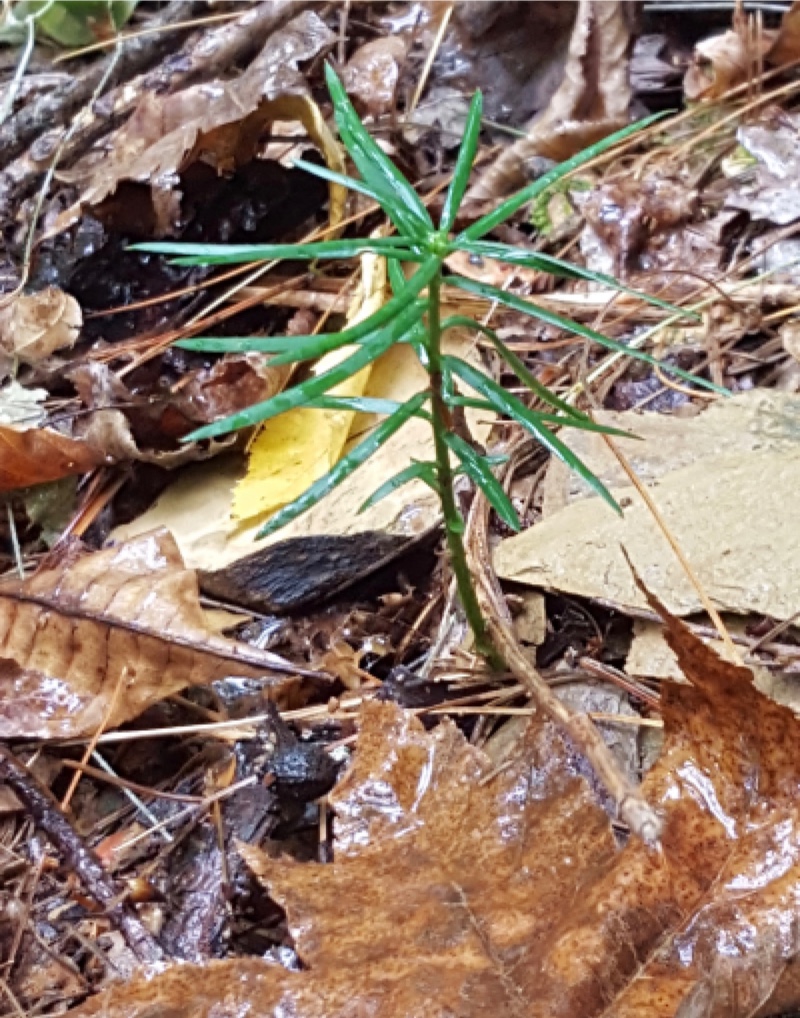 |
|
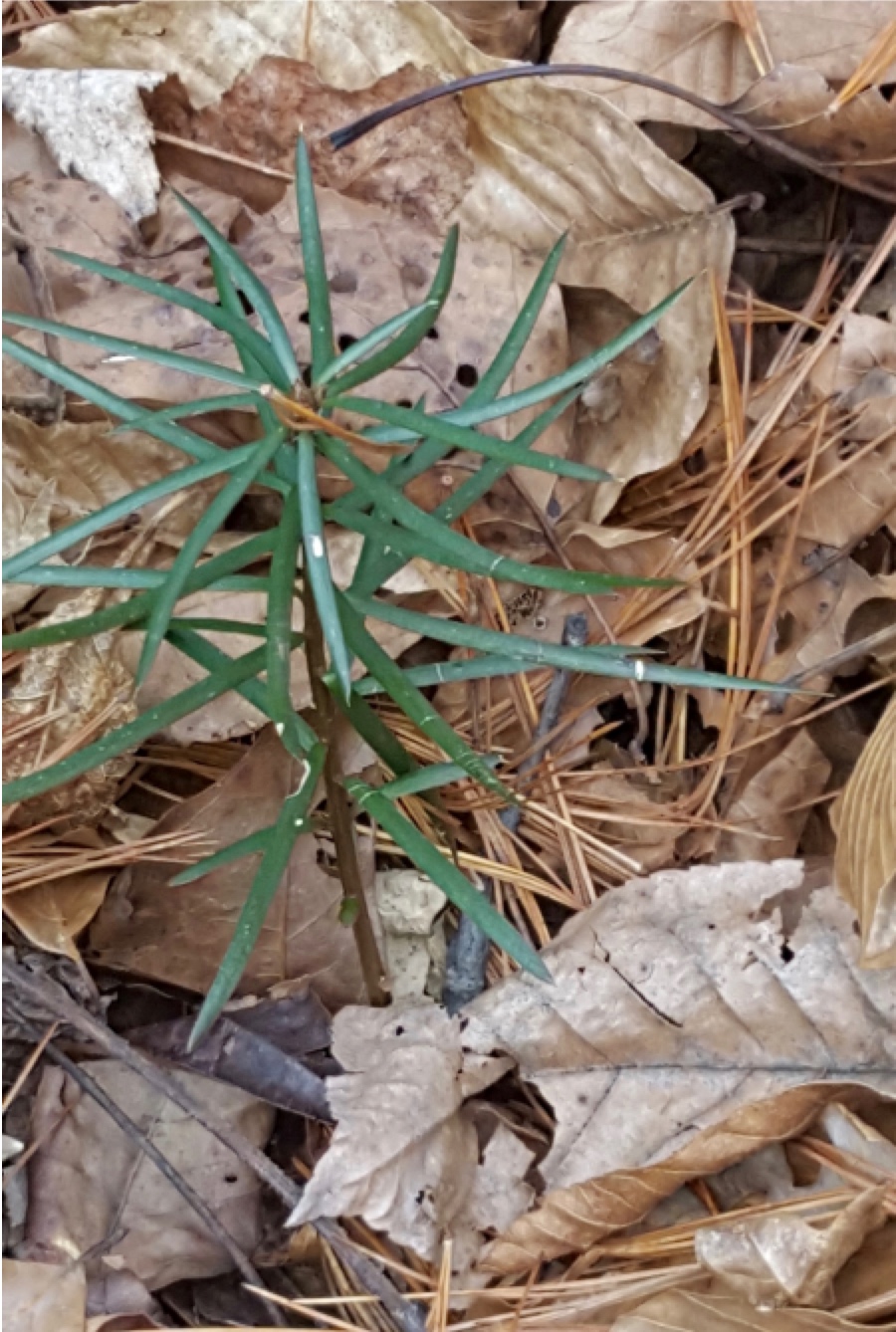 |
|
PHOTOS: Left is Oct 12; Middle is Dec 29.
CLINT BANCROFT of southeastern Tennessee received 200 donated seeds from the Fall 2016 seed crop of a pair of 30-year-old Florida Torreyas in Medford, Oregon. Clint put the seeds in soil in a large outdoor pot within his fenced plant propagation area. But something dislodged the wire mesh cover over that pot and stole all but one of the seeds (which later germinated in that pot).
Nearly 3 years later, Clint stumbled upon 2 seedlings that were a dozen feet from one another, but some 200 feet distant from the pilfered propagation zone.
FULL REPORT
|
• August 2019: Apical cutting of basal clone recovers from herbivory
CLINT BANCROFT of southeastern Tennessee June 2019 report:
"I had an apical cutting of a basal from Highlands NC, about 6 inches tall, that had rooted. This year it put up a 6 inch vertical (no lateral growth, and looked beautiful. [SEE PHOTOS APRIL 2019 ENTRY BELOW.] I left it sitting on top of my cage, 4 feet off the ground, and damned if something did not eat ALL of the new vertical, and also about 2 inches of the original cutting. I suspect it will survive but I have lost a whole year's growth. It will be interesting to see if a chopped off, rooted, apical cutting will establish a new leader."
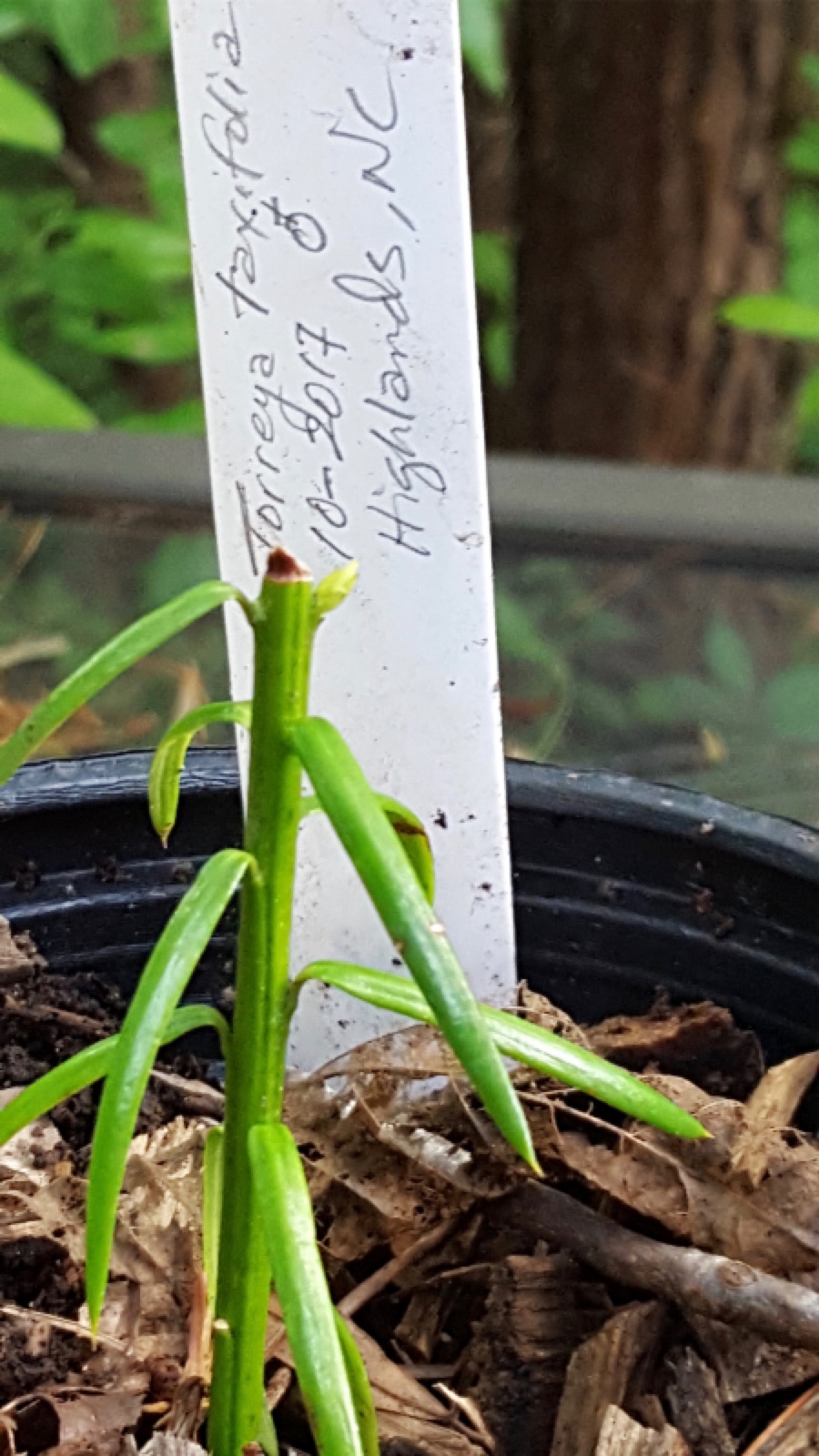 |
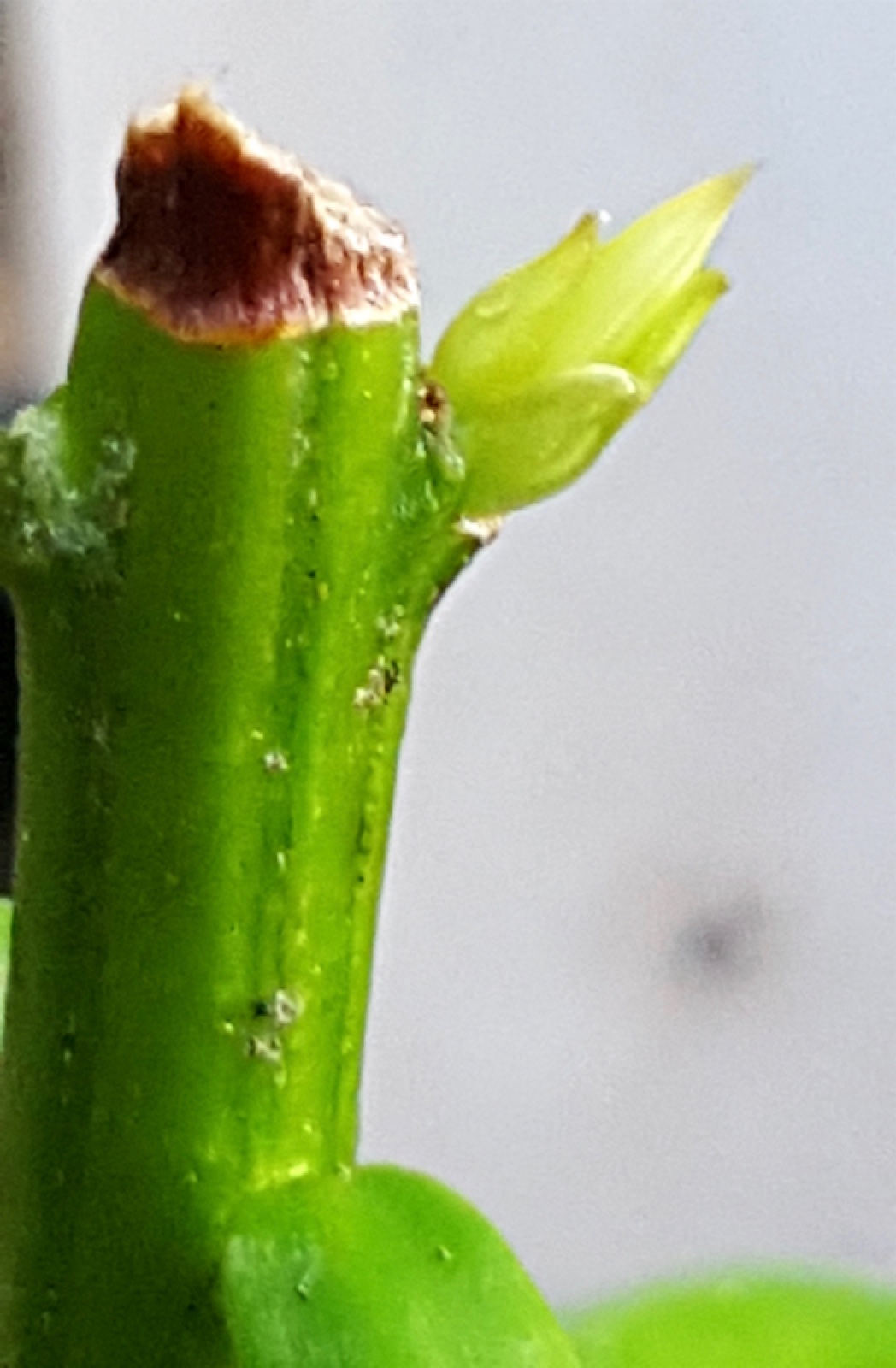 |
|
Clint Bancroft July 2019 update:
"Regarding my accidental experiment in which a rooted apical cutting had put up a new 6 inch vertical and then all but a few inches of the whole plant was eaten.
"In just 2 months or so, the eaten-down stump is putting up what appears to be a new vertical leader."
|
Note by Connie Barlow, August 2019:
"I am reading about Coast Redwood lignotubers and basal growth and propagation now. Genus Sequoia and Torreya, ancient members of Cupressaceae Family, have probably survived this long thanks to their ability to produce new stems from basal growth if the original stem fails (or is logged). The term for what we see in the above photo is an axillary bud doing what it evolved to do — produce a new vertical leader. Apparently all single leaves produced on the vertical main stem each carry on their upper side a suppressed axillary bud. For redwoods, each of those buds can become either a vertical leader or a root, depending on whether it senses air or soil when hormones direct it to wake up. Apparently Torreya can do the same, so we can actually obtain more than one vertical clone from each basal sprout we cut from.
"One final note: More recently evolved members of the Cupressaceae Family maintain this ability (Juniperus), but members of the younger Pinaceae Family (pines, spruce, hemlock) have lost this ability to sprout basals and thereby reestablish vertical growth."
• July 2019: No leaf damage from -15F multi-day freeze, but severe damage from translocation sudden exposure to full sun
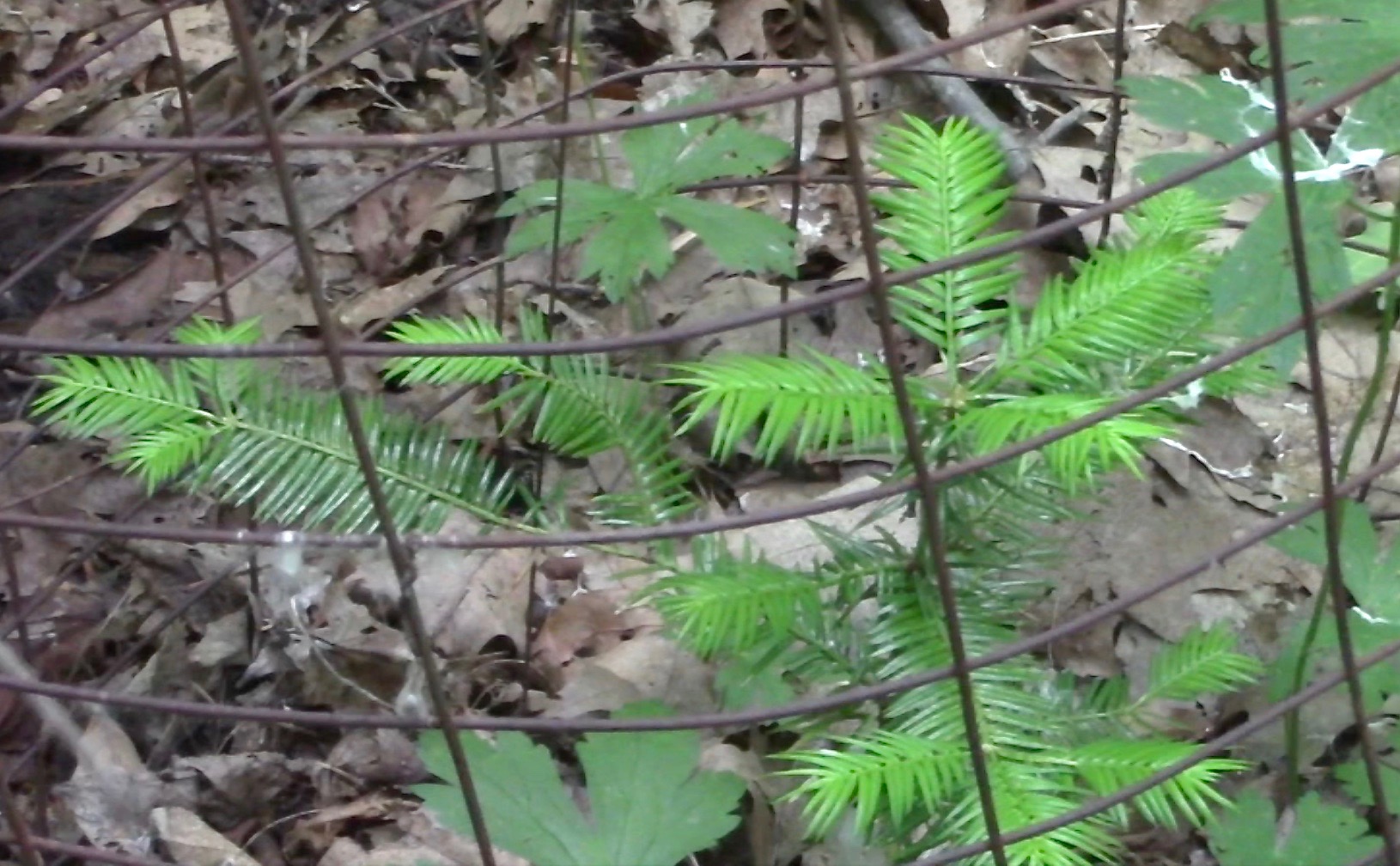 |
|
LEFT: Paul Camire in Capac, Michigan monitored this seedling as -15F temperature ramped into -45 windchill. Snow was too minimal (below the left-most branch) to offer any wind protection. The dark green leaves made it through unharmed, and the light green new growth indicates that even the vegetative buds were unharmed.
|
BELOW LEFT: In contrast, even a single day exposure to full sunlight bleached and killed all upper leaves, sparing a few on the lower branches. Nevertheless, this potted seedling is recovering. It is producing abundant little green buds along the main stem.
BELOW RIGHT: This seedling was in perfect condition until the deciduous canopy overhead suddenly opened to full sunlight, owing to the fall of a beetle-killed Ash tree. Notice the bleached tips of leaves on the middle layer branches, and the bare branches at the upper level, where bleached leaves have fallen away. Nonetheless, there is strong recovery: light green new growth at branch tips and 3 fresh lateral branches radiating from the leader.
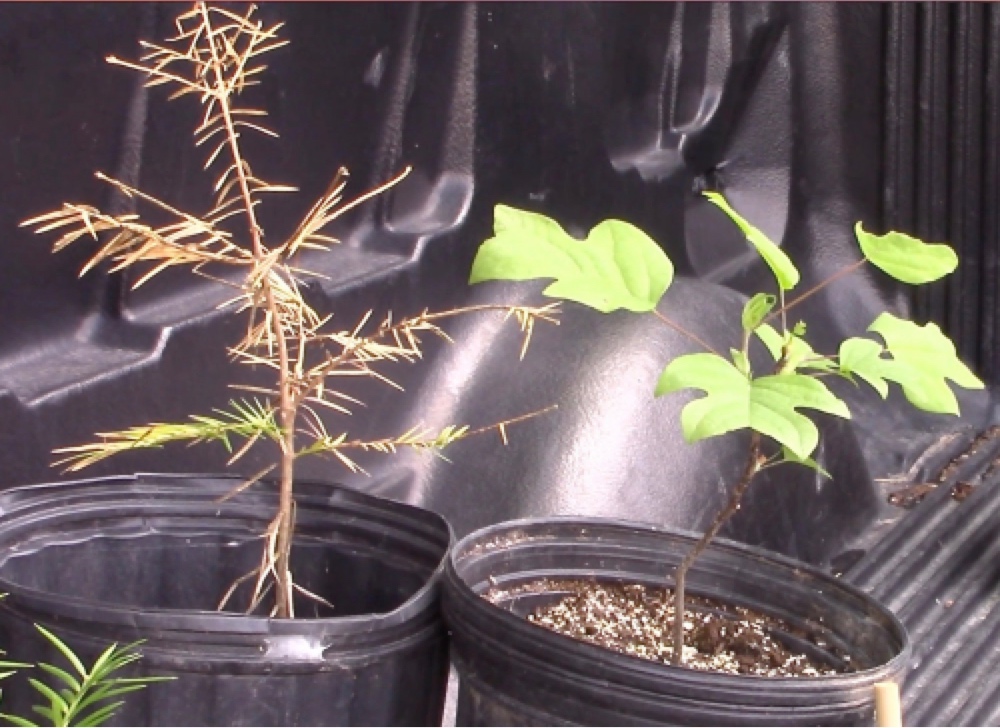 <
<
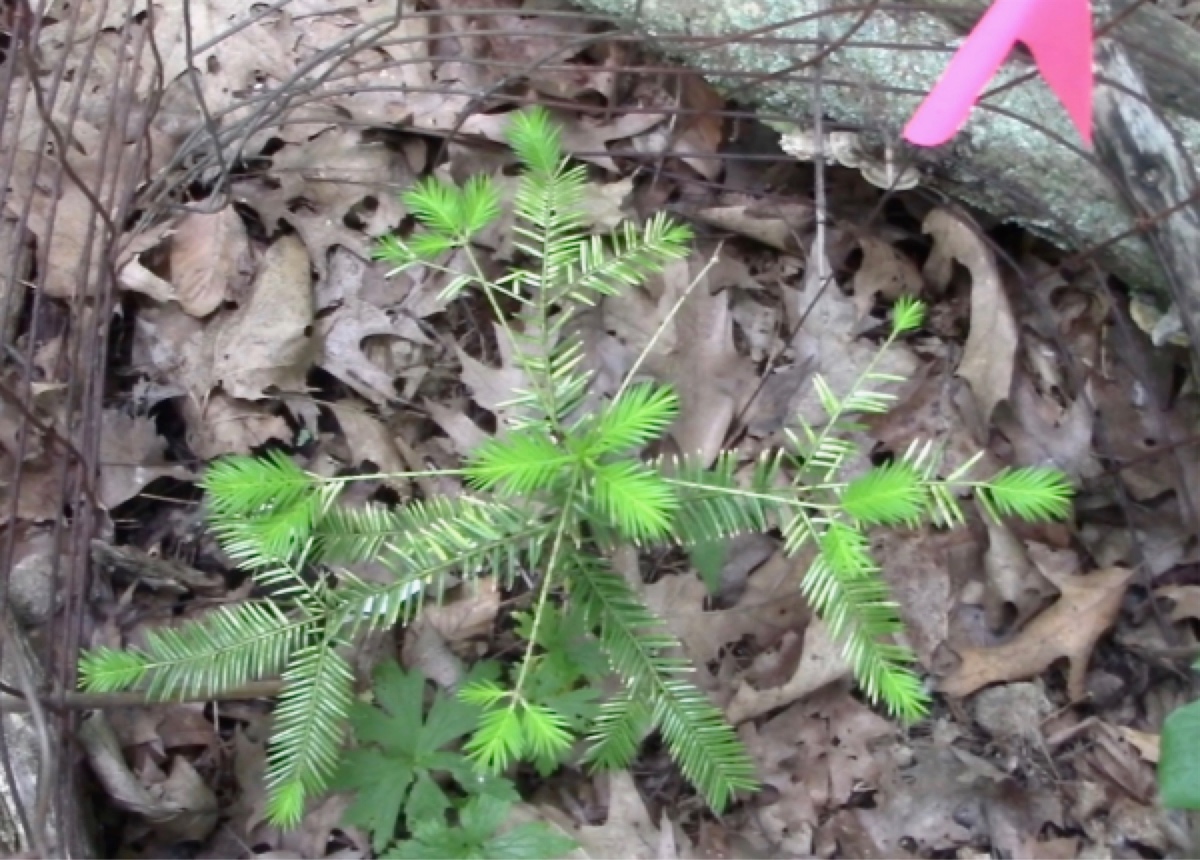
• April 2019: California fires show Torreya californica resprouting basals after fire kills main stem and all the nearby pines
ZACH ST. GEORGE sent 4 photos of multi-age California Torreyas he saw during a hike in Stevenson State Park (northwest mountains of Napa Valley, north of San Francisco, Coast Range). He wrote:
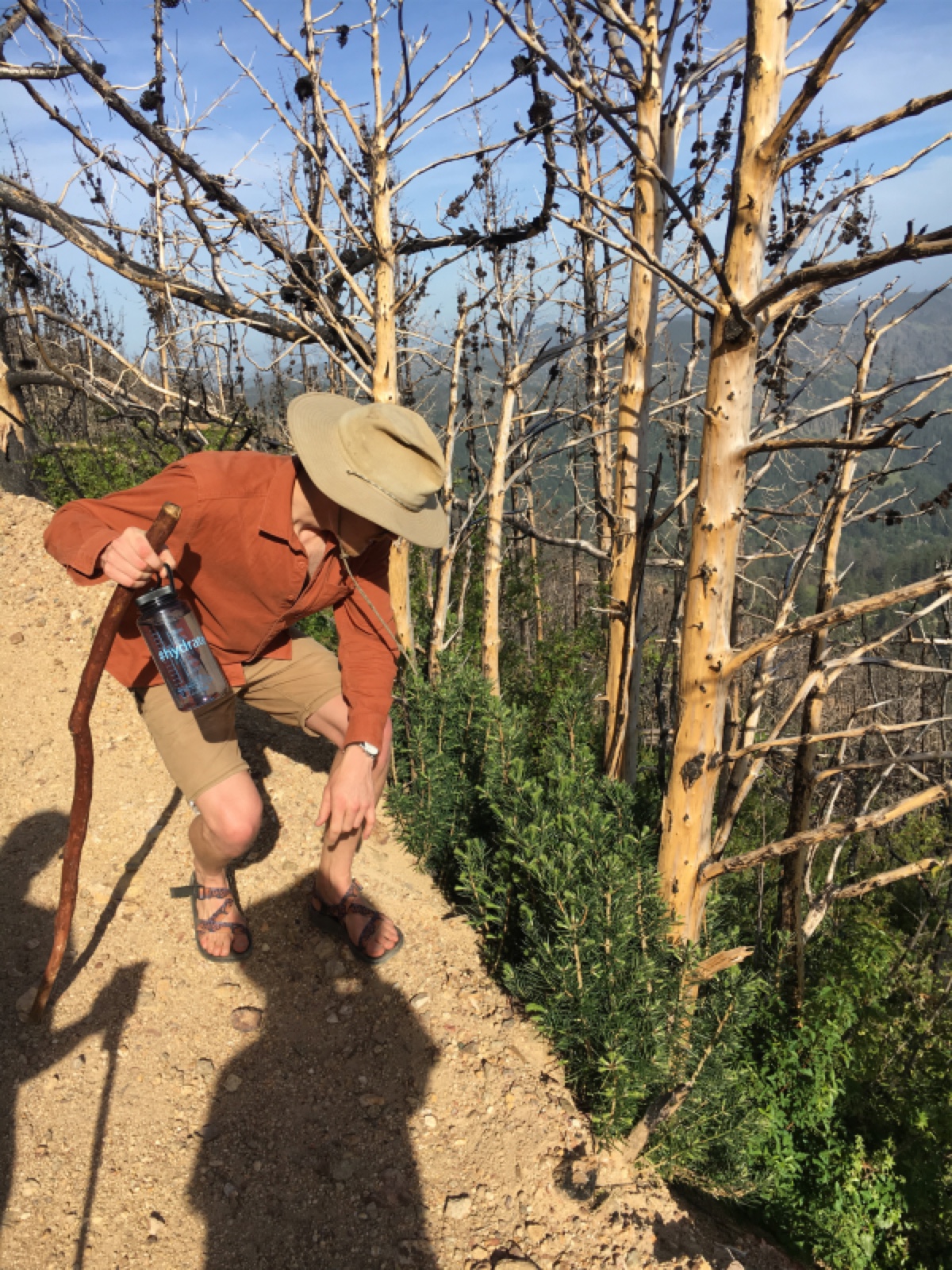 |
|
 |
|
"We walked through a large area that had burned recently, I'm thinking last fall.
It was a crown fire, and all of the mature trees (mostly pine) were dead. A few oaks / tanoaks survived. But I noticed a bunch of torreyas coppicing around some dead trunks. They were far bigger than the seedling pines that surrounded them, although I suspect the pines will catch up quickly."
|
EDITOR'S NOTE: Notice the yellow color of the Torreya standing trunks, after its bark had burnt and fallen fallen off. Torreya's remarkable survival capacities (the genus originated in the Jurassic) owe in part to its ability to prolifically sprout new stems from its root crown after the main stem is injured or killed. Notice how these basals are already achieving a lot of photosynthesis — which is crucial in order for the individual to keep its roots alive. Eventually, one or two of the basals will begin to rapidly grow tall, while the remaining basals continue to photosynthesize, so long as sunlight penetrates to their spot near the ground.
In 2005 I got a chance to visit and photograph California Torreya in
the wild (see the California Torreya section of this website). Viewing this sister torreya species in the wild made a huge difference in how I have scouted for ideal landscapes for planting Florida Torreya seeds and seedlings in the eastern USA. Now with this post-fire photo, we have a significant new learning. And it means that Paul Martin's 2004 indigenous fire hypothesis as the cause of Florida Torreya's inability to return northward during the Holocene is conclusively wrong. Instead, my own favored hypothesis is that while the Chattahoochee River provided swift passage from the Appalachian Mountains southward to the Apalachicola of Florida during glacial cooling, Torreya's seed was unable to tap into river flow in order to return to favorable climates as the Holocene warmed. Learn more about how my own visit to the Chattahoochee River in 2015 generated my river-flow hypothesis.
• April 2019: Proof that cutting of basal leader tip yields tree-form Torreya
April 24 email from Clint Bancroft (Torreya planter in Ocoee watershed of Tennessee) to Connie Barlow:
"Look at the new growth on this cutting from Harbison House (Highlands, NC)! The cutting is the apical tip from a basal of one of the mature trees."